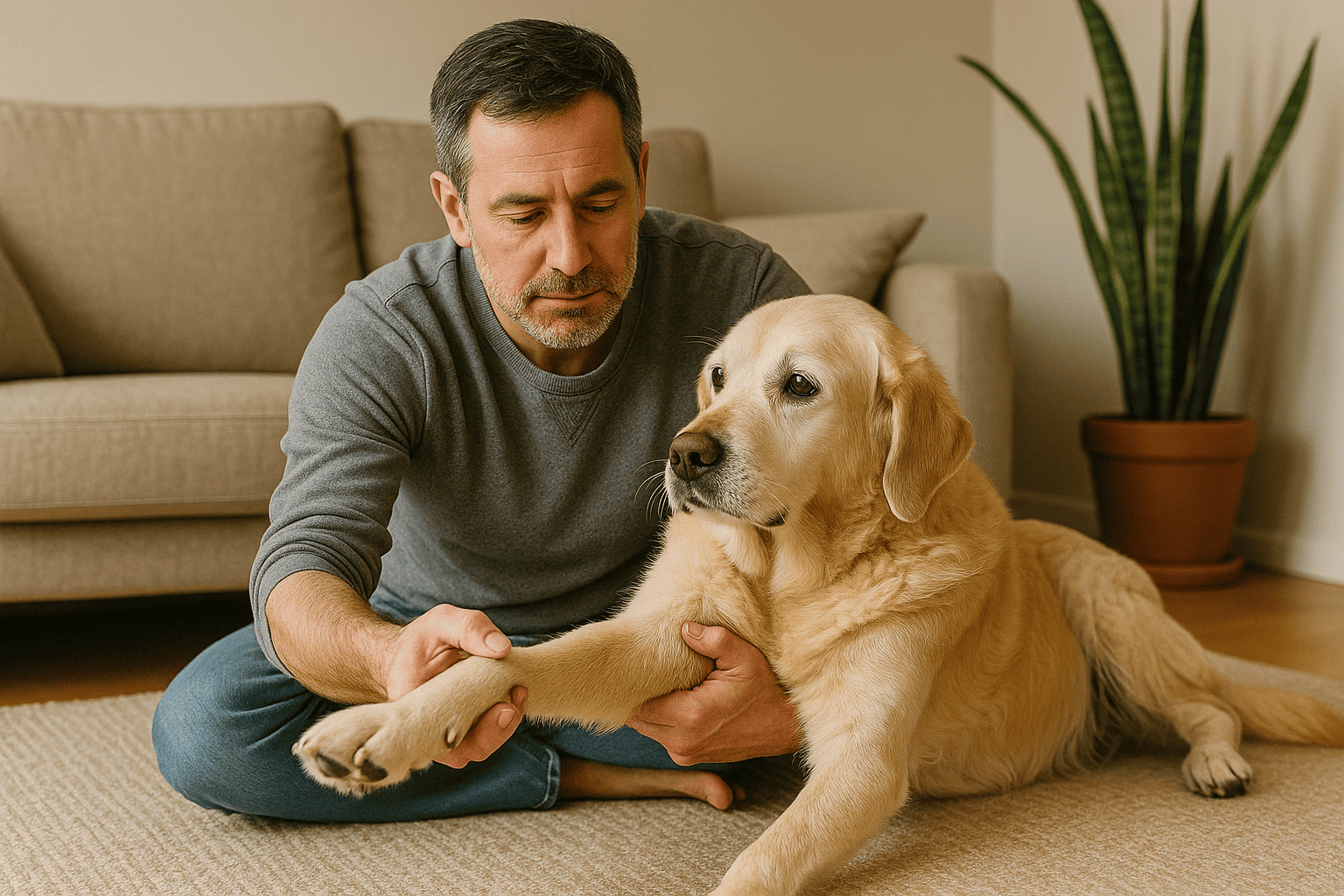Introduction
Arthritis is a common issue for senior dogs, leading to joint pain, stiffness, and limited mobility. While medications and therapies are helpful, incorporating stretches for senior dogs with arthritis can significantly improve their comfort and quality of life. Gentle stretching increases flexibility, reduces muscle tension, and eases joint stiffness, supporting safer movement. In this article, we’ll share five simple, vet-approved stretches you can do at home to help your senior dog feel better and move more easily, enhancing their daily well-being.
Why Stretching Helps Senior Dogs
Stretching is a powerful tool for managing arthritis in aging dogs. It promotes physical health and comfort by addressing key issues caused by joint inflammation. Here’s how it benefits your dog:
- Increases Flexibility: Stretching loosens tight muscles and joints, improving range of motion.
- Reduces Muscle Tension: Gentle movements relieve tightness, easing discomfort.
- Improves Circulation: Enhanced blood flow delivers nutrients to joints, reducing inflammation.
- Eases Joint Stiffness: Regular stretching keeps joints mobile, preventing stiffness from inactivity.
- Supports Safer Movement: Stronger, more flexible muscles reduce the risk of injury during activity.
These benefits make stretches for senior dogs with arthritis a vital part of their care routine.
Front Leg Extension
How to Perform
This stretch targets the shoulder and elbow joints, helping to relieve stiffness in the front legs.
- Have your dog stand or lie on their side comfortably.
- Gently hold one front leg just above the paw.
- Slowly extend the leg forward, as if your dog is reaching out.
- Hold for 5–10 seconds, then release gently.
- Repeat 2–3 times on each front leg.
Tips for Success
Never force the movement. If your dog shows resistance or discomfort, stop and try again later. Perform this stretch in a calm environment to keep your dog relaxed.
Rear Leg Stretch
How to Perform
This stretch focuses on the hips and knees, easing lower body stiffness for senior dogs with arthritis.
- Position your dog lying on their side.
- Gently support one rear leg, holding it securely.
- Slowly pull the leg straight back, aligning it with the body.
- Hold for 5–10 seconds, then return to a relaxed position.
- Repeat 2–3 times per leg.
Tips for Success
Do this stretch after a short walk when your dog’s muscles are warm, as this enhances flexibility and reduces the risk of strain.
Neck Side Stretch
How to Perform
This stretch improves flexibility in the neck and upper spine, promoting easier head movement.
- Have your dog sit or stand in a comfortable position.
- Hold a treat and slowly move it toward one shoulder, encouraging your dog to turn their head.
- Allow a gentle neck twist as they follow the treat.
- Hold for a few seconds, then reward with the treat.
- Repeat 3–5 times on each side.
Tips for Success
Use this stretch as a bonding opportunity. Move slowly and keep the experience positive to build trust and comfort.
Spine Flex and Stretch
How to Perform
This gentle stretch mobilizes the spine, reducing overall stiffness in senior dogs with arthritis.
- Position your dog standing comfortably.
- Hold a treat near their chest, then slowly move it backward along their belly toward the tail.
- Your dog will slightly curve their body to follow the treat.
- Repeat slowly 3–4 times in both directions.
Tips for Success
Ensure smooth, controlled movements to avoid strain. Stop if your dog seems uncomfortable or struggles to follow the treat.
Gentle Back Massage with Stretch
How to Perform
Combining a light massage with a spine stretch improves circulation and reduces tension.
- Have your dog lie down in a relaxed position.
- Use your fingers to apply gentle pressure along the spine in small, circular motions.
- Slowly stroke down their back toward the tail.
- Allow your dog to stretch naturally during or after the massage.
- Spend 1–2 minutes on this activity.
Tips for Success
Create a calming atmosphere with soft music or dim lighting to help your dog relax. Keep the massage gentle to avoid discomfort.
Safety First: Veterinary Guidance
Before starting stretches for senior dogs with arthritis, consult your veterinarian, especially if your dog has moderate to severe arthritis. A vet can assess your dog’s condition and recommend safe techniques tailored to their needs. During stretching, watch for signs of discomfort, such as:
- Limping or favoring one leg
- Whining or vocalizing pain
- Resistance to movement or stiffness
If these occur, stop immediately and contact your vet for guidance. Professional advice ensures your stretching routine is safe and effective.
Conclusion
Incorporating these five simple stretches into your senior dog’s daily routine can significantly relieve arthritis pain and improve mobility. By spending just a few minutes each day on stretches for senior dogs with arthritis, combined with a healthy diet and regular vet check-ups, you can help your furry friend enjoy a more comfortable, active life. Try these stretches today and share your dog’s progress in the comments!
Tip: Avoid forcing any movement. If your dog resists, stop and try again later.
2. Rear Leg Stretch
Perfect for hips and knees, this stretch helps ease lower body stiffness.
How to do it:
- With your dog lying on their side, gently support one rear leg.
- Slowly pull the leg straight back in line with the body.
- Hold for 5–10 seconds and return to a relaxed position.
- Repeat 2–3 times per leg.
Tip: Perform this after a short walk when muscles are warm and relaxed.
3. Neck Side Stretch
This stretch promotes flexibility in the neck and spine.
How to do it:
- Have your dog sit or stand comfortably.
- Hold a treat and move it slowly toward one shoulder, encouraging your dog to turn their head to the side.
- Let them follow the treat for a light neck twist.
- Hold the position for a few seconds, then offer the treat.
- Repeat 3–5 times on each side.
Tip: This is a great bonding moment—be gentle and patient.
4. Spine Flex and Stretch
This gentle spine mobilization can help relieve overall stiffness.
How to do it:
- With your dog standing, hold a treat near their chest.
- Slowly move the treat backward along their belly toward the tail.
- Your dog will curve their body slightly to follow the treat.
- Repeat slowly 3–4 times in both directions.
Tip: Make sure your dog’s movements are smooth and controlled.
5. Gentle Back Massage with Stretch
A light massage paired with a spine stretch can improve circulation and reduce tension.
How to do it:
- Have your dog lie comfortably.
- Use your fingers to apply gentle pressure along the spine in small circles.
- Slowly stroke down their back toward the tail.
- Let them stretch naturally during or after the massage.
Tip: Keep the environment calm, and use soft music to help your dog relax.
Safety First: When to Consult a Vet
Always talk to your vet before starting a stretching routine—especially if your dog has moderate to severe arthritis. Watch for any signs of discomfort, like limping, whining, or resistance to movement. If your dog shows these signs, stop the exercise and consult your vet.
Make Stretching a Daily Habit
Just a few minutes a day can make a big difference in your senior dog’s comfort and mobility. Combine stretching with short walks, a healthy diet, and lots of love to support your dog’s aging body in the best way possible.

